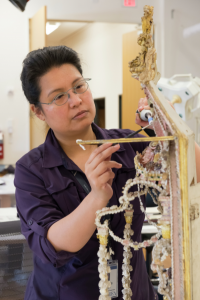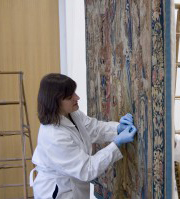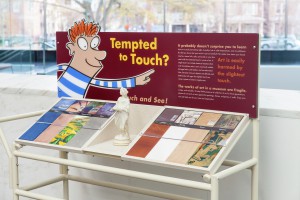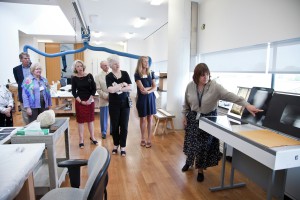Conservation is one of many essential activities happening at VMFA. Our conservators quietly care for every area of the collection. Their daily tasks vary tremendously—in keeping with the scope of VMFA’s holdings—yet always serve a single goal: preserving 33,000 treasures for future generations to enjoy.
VMFA’s Experts

Shelia Payaqui, Conservator
VMFA Photo Resources
VMFA’s two conservation departments are led by Carol Sawyer, Margaret H. and William E. Massey Senior Conservator of Paintings, and Shelia Payaqui, Chief Conservator of Sculpture and Decorative Arts, who together have more than 40 years of experience with the museum’s collection. To properly care for the diverse range of cultures, time periods, and media represented in VMFA’s encyclopedic collection, the museum’s in-house staff periodically contracts with outside experts who specialize in books, textiles, or works on paper.
The Process
Evaluating the condition of a work of art, identifying areas of damage, natural deterioration, or alteration, is the foundation of all conservation projects. These meticulous assessments punctuate the life of a museum object: potential acquisitions are reviewed to ensure that they meet VMFA’s exacting standards; works of art are evaluated before being included in an exhibition or loaned to another institution; and returning loans are scrutinized to make sure they have traveled safely. At every stage, the object’s condition is carefully documented and these notes, measurements, and photographs become part of its record.

Conservation in process.
What the conservators look for during these evaluations varies according to the object—its age, component materials, construction, culture of origin, and evidence of previous conservation treatments. Their judgments are informed by extensive training in art history, studio art, materials science, and chemistry, as well as practical experience. In addition to this unusual blend of talents, conservators bring formidable patience and rigorous attention to detail to what is a slow and painstaking process.
Once a conservation project is complete and the work of art is ready for public view, the treatment may be imperceptible to the casual visitor. While a new exhibition or educational program may be more visible to the public, caring for the objects entrusted to our care just as surely advances VMFA’s mission as Virginia’s art museum.
A Unique Perspective

VMFA Please Touch Education/Conservation Kiosk
Visitors will be encouraged to touch and learn why touching is so hazardous to our collection. Phase 2 of this project will the installation of strategically placed graphics/signs reminding visitors to refrain from touching. Conservators, curators and educators will work together to find perfect placements of these signs.
Richard and Caroline T. Gwathmey Memorial Trust for provided grant funds for this project
To museum-goers trained never to touch the art, seeing a conservator work with an object is astonishing. Yet they wield this power with the greatest restraint and respect for the original intentions of the artist. Conservators see themselves as part of a long line of caretakers for each object. As much as they look to the past to understand how a work was created and what has happened to it in the intervening years, conservators always act with an eye to the future. Every treatment performed on a work of art is localized to the area of damage and intended to be entirely reversible. Should new materials or techniques become available, subsequent conservators working 50 or even 500 years from now will be able to apply those advances.
In preparation for treating an object, conservators may perform a variety of technical analyses to guide their efforts. With a tool kit that includes radiography, x-ray florescence, infrared reflectography, and microscopy, the conservator’s work is a marriage of science and art. Gillis uses x-ray florescence to distinguish metals that appear similar, such as gold and gilded silver, but which require different treatments. A tiny cross section of a painting’s pigment and ground layers—no bigger than a grain of salt—when viewed under a microscope helps Sawyer understand the pigments and media used, as well as the method of paint layering to achieve a particular effect in the finished work. Technical research can also yield exciting discoveries that enhance our understanding of an artist’s materials, techniques, and working methods. An x-ray of a sculpture’s underlying armature may provide insight into the evolution of an artist’s process, while an x-ray of a painting can reveal “pentimenti” or artistic changes in the composition. Technical analysis is also essential to authenticating a work of art—or exposing a forgery.
A state-of-the-art space for conservation

Photo: Travis Fullerton © 2013 Virginia Museum of Fine Arts
Donor prospect tour of David and Susan Goode Conservation Studios with Object Convervator, Kathy Gillis, April 17, 2013
The David and Susan Goode Conservation Studios are one of the hidden assets of the new McGlothlin Wing completed in 2010. The airy 9,500–square foot suite is flooded with natural light from a long bank of windows that stretch nearly to the 15-foot ceilings, as well as interior skylights. The studios’ design is beautiful and functional, the result of a collaboration between the architects and VMFA’s conservators. Indirect, northern light is essential for color matching and cleaning works of art. The combination of windows and skylights ensures uniform lighting throughout the space so that the intensity and color will be the same whether a work is mounted on an easel near the windows or laid flat on a table. Likewise, the flooring mirrors that of the galleries so that the conservators can gauge how the work will look once it’s installed in an exhibition. The high ceilings are able to accommodate traditional full-length portraits and monumental works of contemporary art.